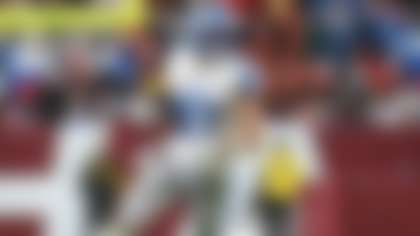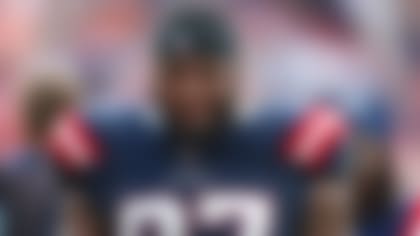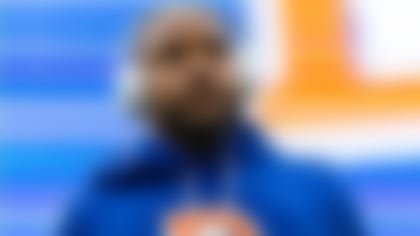Trent Baalke didn't go into the past two drafts looking to augment the training room.
But it wasn't a mistake, either, that the San Francisco 49ers general manager wound up rolling the dice repeatedly on players still making their way back from injury.
The decisions, most certainly, are complicated ones. They're also made with a pretty clear plan in mind.
"To answer the question, yes, it is a conscious decision we made to do that," Baalke said from his office Friday, as rookie minicamp kicked off in Santa Clara, California. "You know there's a possibility that, if the board falls a certain way, that's a decision that could be made. But it's not just the last two years -- we've just been in position to make those picks the last two years. It really comes down to value."
Whether it's a coincidence or not, the Niners have fast become the poster boys for the practice of gambling on banged-up big-timers, with the idea being to draft them, redshirt them and reap the benefits down the line.
Defensive lineman Tank Carradine and running back Marcus Lattimore were widely considered first-round talents going into the 2012 college campaign, but both went on to suffer season-ending knee injuries. As a result, the 49ers got those two in the second and fourth rounds, respectively, of the 2013 NFL Draft. Similarly, defensive lineman Quinton Dial suffered a turf-toe injury at the end of his career at Alabama and, as a result, fell to the fifth round, where the Niners snatched him up.
The three combined to play 18 snaps, all by Dial, in 2013. But all three are expected to compete for significant roles in 2014.
Meanwhile, Baalke and 49ers coach Jim Harbaugh were back at it again earlier this month, taking Clemson offensive lineman Brandon Thomas with the 100th overall pick, just over a month after he tore his ACL in a private workout with the New Orleans Saints, and Florida Atlantic cornerback Keith Reaser, who tore his ACL last October, in the fifth round.
"Anytime a player gets injured, there's the possibility that they never reach pre-injury form again," Baalke said. "That's a reality of what we do. But at the same time, it goes back to the risk-reward and the work you do. What's your research? You can minimize the risk by doing a very good job in researching the injury, in researching the individual. You increase your odds of a positive outcome by being thorough."
Having positive experiences to draw on doesn't hurt, either. During Baalke's first year in San Francisco -- he was an area scout -- the Niners drafted Miami running back Frank Gore, who already had torn both ACLs during his college career. Gore's gone from injury-prone prospect to seemingly indestructible pro, with 12,739 all-purpose yards, five Pro Bowls nods and seven 1,000-yard rushing campaigns in the books. Two years after drafting Gore, the Niners took another third-round risk in Ray McDonald, who had suffered a serious knee injury of his own during his tenure at Florida. McDonald's now entering his eighth year as a rock-solid piece on San Francisco's D-line.
The calculated risks San Francisco has taken in the past two drafts are a bit different, with those players drafted fresh off injury -- as opposed to just having an injury history, like Gore and McDonald. But the process is similar.
On the medical end, the football people lean on lead orthopedist Dr. Tim McAdams and director of football operations and sports medicine Jeff Ferguson to separate serious injuries from catastrophic ones. From there, Baalke and Co. try to dig inside the individual to find his motivation.
"We're looking for guys that love the game and will do whatever it takes to be a part of it and get themselves ready to play," Baalke said. "And then there's their mental toughness. You know that they're not only going to have to deal with the physical issues and rehabilitation, but also the psychological side of it. Sometimes, the psychological part can be more restrictive than the physical."
Beyond that, there's the makeup of your own team. The Niners went into the 2013 NFL Draft with 13 picks and entered this year's event with 11 -- that, in Baalke's words, "makes it easier to justify taking a player you may have sit for a year." In San Francisco's case, it also helps to have decision-makers with job security and a loaded roster without a lot of immediate needs.
Today's hysteria over the draft means classes are graded in the immediate aftermath of the process and often dismissed or approved after just a year or two. With picks like Lattimore or Carradine or Thomas, more patience is required. But based on cases like Dominique Easley's -- the New England Patriots just took the Florida defensive tackle in Round 1 despite the fact that he suffered torn ACLs during his sophomore and senior seasons -- the Niners seem to have put a trend in motion where such risk-taking is becoming more commonplace.
So with that -- and Baalke's philosophy -- in mind, here's an update on some 2013 redshirts, as well as a quick look at the 2014 group (all listed alphabetically):
CLASS OF 2013
Tank Carradine, DE/OLB, San Francisco 49ers: Baalke told me that both Carradine and Lattimore "are working extremely hard. There are no limitations on them, and they're competing for roles on this team." And Carradine appears to be in a great spot to contribute in 2014. At worst, he's likely in the D-line rotation. At best, he's a versatile piece San Francisco can use on the edge, too, should Aldon Smith end up missing a significant amount of time.
Quinton Dial, DL, San Francisco 49ers: Dial wasn't a true redshirt last year -- he came off the NFI list in October and logged time in three games. But he also didn't make much of a dent as a rookie. A mountain of a man at 6-foot-5 and 318 pounds, Dial could fit inside or outside along the Niners' deep line group, and is -- at the very least -- a promising developmental type.
Brandon Jenkins, OLB, Washington Redskins: A Lisfranc injury cost Jenkins his final season at Florida State and hurt his stock going into the draft. An ankle injury suffered early last fall further complicated things, substantially limiting Jenkins' duties as a rookie. Jenkins' potential makes him an interesting 24-year-old prospect for Washington, especially given the uncertain D.C. futures of stalwarts Brian Orakpo and Ryan Kerrigan.
Marcus Lattimore, RB, San Francisco 49ers: There's nice symmetry to the idea he could eventually succeed Gore, since the two had similarly checkered injury histories at the college level. But Lattimore will have to earn his snaps, with 2014 second-round pick Carlos Hyde bringing similar early-down edge to a crowded group behind No. 21.
Kapron Lewis-Moore, DL, Baltimore Ravens: Part of a stout Notre Dame front in 2012, Lewis-Moore blew out his ACL in the BCS championship game against Alabama, then fell into Baltimore's lap in the sixth round two Aprils ago. His timing isn't bad here: With Arthur Jones off to Indy via a big free-agent deal, there's a spot open on the Baltimore line. Lewis-Moore will be in the mix with Brandon Williams and rookie Timmy Jernigan.
Jamar Taylor, CB, Miami Dolphins: The Boise State prospect tumbled to the 54th pick thanks, at least in part, to kidney damage. And less than a month after he was drafted, Taylor had sports-hernia surgery. All of that significantly impacted his rookie season, even though he did appear in nine games. Now healthy, Taylor is fully expected to compete with Cortland Finnegan for the starting spot opposite Brent Grimes.
CLASS OF 2014
Aaron Colvin, CB, Jacksonville Jaguars: Had Colvin not torn his ACL at the Senior Bowl, he might have gone in the second round. Instead, he was taken in the fourth and likely will open the season on the PUP list, which would sideline him for (at least) the first six games of the year. Long term, Colvin could be another valuable young piece in a secondary that boasts promising sophomores John Cyprien, Dwayne Gratz and Josh Evans.
Dominique Easley, DL, New England Patriots: Before the 2013 NFL Draft, I was asking a southeast area scout about Florida defensive lineman Sharrif Floyd, and after heaping praise on Floyd, the scout said, "Wait till you see the next guy." That guy was Easley. Floyd's former Gator teammate then went on to tear his right ACL in September, just two years after tearing his left ACL. Physically, Easley should be ready in the fall. But all things considered, it'd be hard to expect a ton from him before 2015.
Brandt: Instant-impact rookies
Forget about depth-building developmental prospects -- Gil Brandt lists six rising rookies poised to turn heads with their play now. **READ**
Zach Mettenberger, QB, Tennessee Titans: As of last November, the former Georgia Bulldog had rehabbed his pro stock completely, coming into his own under new LSU offensive coordinator Cam Cameron. Then he tore his ACL. And there was the diluted drug-test sample at the NFL Scouting Combine. Now? Nashville is actually a nice spot for the sixth-round pick. While he'll likely be behind Jake Locker and Charlie Whitehurst on the depth chart in 2014, the Titans' future at QB is wide open.
Trey Millard, FB, San Francisco 49ers: Widely considered the top fullback in the draft class, Millard blew out his ACL in October. The smashmouth Niners need more long-term depth at the position, having lost Anthony Dixon to free agency. And while starter Bruce Miller just signed a contract extension, he finished last season on injured reserve. So long as Millard can get healthy, he should -- based on his production at Oklahoma -- bring value as a runner and receiver in 2015.
Aaron Murray, QB, Kansas City Chiefs: The other SEC quarterback to suffer a late-season ACL tear, Murray participated in minicamp last weekend and reported that he wasn't limited. Still, he's likely to be inactive most weeks -- behind Alex Smith and Chase Daniel -- as he works his way back. Andy Reid's history of developing QBs makes Murray one to watch going forward.
Keith Reaser, CB, San Francisco 49ers: Reaser tore his ACL in October, rehabbed for four months, then needed a second surgery after being red-flagged at the combine. A cousin of former Redskins star Sean Taylor, Reaser has the physical tools to be a long-term producer for the Niners in the secondary. And San Francisco is content to give him time to get right physically.
Brandon Thomas, OG, San Francisco 49ers: The Niners likely will put Thomas on NFI in 2014, extending his rookie deal another year. After that, he could be an important part of San Francisco's future. The contracts of starting guards Mike Iupati and Alex Boone are up after this year and next year, respectively. Iupati and Boone are 27 and likely will be able to cash in on the market, making it improbable the Niners keep both.
Now, there should be addendums to both lists, as well.
Last year, a number of players were injured after being drafted but before the season started. Thus, they wound up redshirting and could become contributors this year. Among them: Cardinals OG Jonathan Cooper, Redskins S Phillip Thomas, Texans OLB Trevardo Williams and Bengals OLB Sean Porter. There are others, like Panthers OG Edmund Kugbila, who are still not out of the woods, injury-wise.
And then, in the '14 group, there are players like Chargers CB Jason Verrett, Buccaneers TE Austin Seferian-Jenkins, Broncos WR Cody Latimer and Ravens DL Brent Urban who suffered less-serious injuries, but are being shepherded through spring slowly.
A lot to consider? Sure it is. But as Baalke says, "There's a probability for missing with healthy guys, as well."
Follow Albert Breer on Twitter @AlbertBreer.



